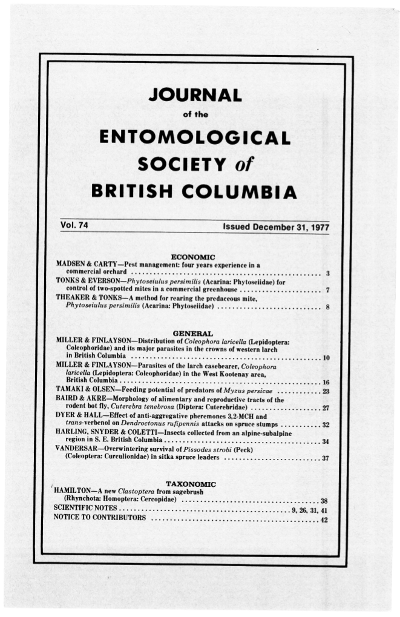Feeding potential of predators of <i>Myzus persicae</i>
Keywords:
green peach aphid, <i>Myzus persicae</i>, <i>Orius tristicolor</i>, <i>Coccinella transversoguttata</i>, predator,Abstract
A rate of feeding for predator insects on the green peach aphid, <i>Myzus persicae</i> (Sulzer), was determined based on the number of aphids consumed from a more natural environment corrected for reproduction and natural death. Of the predator species studied, the largest, <i>Coccinella transversoguttata</i> Falderman, consumed about 10 times more aphids than the smallest, <i>Orius tristicolor</i> (White), and about 7 times more than the average for all other predator species combined.References
Goodarzy, K. and D.W. Davis. 1958. Natural enemies of the spotted alfalfa aphid in Utah. J. Econ. Entomol. 51:612-6.
Madsen, H.F. 1961. Notes on Anthocorus melanucerus Reuter (Hemiptera: Anthocoridae) as a predator of the pear psylla in British Columbia. Can. Entomol. 93:660-2.
Mitchell, B. 1963. Ecology of the two carabic beetles, Bembedion lampros (Herbst) and Trechus quadristriatus (Shrank). I. Life cycles and feeding behavior. J. Anim. Ecol. 32:289-99.
Simpson, R.G. and C.C. Burkhardt. 1960. Biology and evaluation of certain predators of Therioaphis maculata (Buckton). J. Econ. Entomol. 53:89-94.
Smith, R.F. and K.S. Hagen. 1956. Enemies of spotted alfalfa aphid. Calif. Agric. 10:8-10.
Tamaki, G. 1972. The biology of Geocoris buttalus inhabiting orchard floors and its impact on Myzus persicae on peaches. Environ. Entomol. 1:559-65.
Tamaki, G., J.U. McGuire, and J.E. Turner. 1974. Predator power and efficacy: A model to evaluate their impact. Environ. Entomol. 3:625-30.
Tamaki, G. and R.E. Weeks. 1968. Anthocoris melanocerus as a predator of the green peach aphid on sugar beets and broccoli. Ann. Entomol. Soc. Am. 61:579-84.
Watson, T.K. and W.H.A. Wilde. 1963. Laboratory and field observations of two predators of pear psylla in British Columbia. Can. Entomol. 95:435-8.
Downloads
Published
Issue
Section
License
Authors who publish with the Journal of the Entomological Society of British Columbia agree to the following terms:
-Authors retain copyright and grant the journal right of first publication with the work simultaneously licensed under a Creative Commons Attribution License that allows others to share the work with an acknowledgement of the work's authorship and initial publication in this journal.
-Authors are able to enter into separate, additional contractual arrangements for the non-exclusive distribution of the journal's published version of the work (e.g., post it to an institutional repository or publish it in a book), with an acknowledgement of its initial publication in this journal.
-Authors are permitted and encouraged to post their work online (e.g., in institutional repositories or on their website) prior to and during the submission process, as it can lead to productive exchanges, as well as earlier and greater citation of published work (See The Effect of Open Access).


